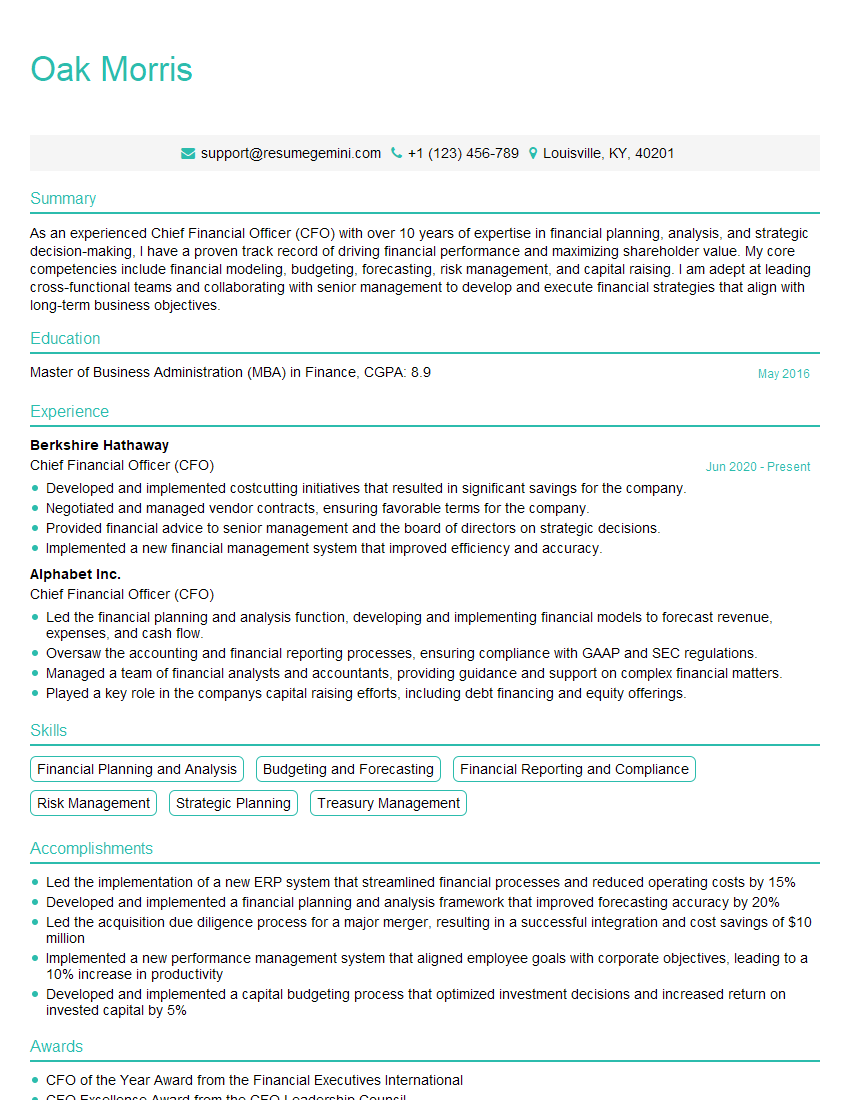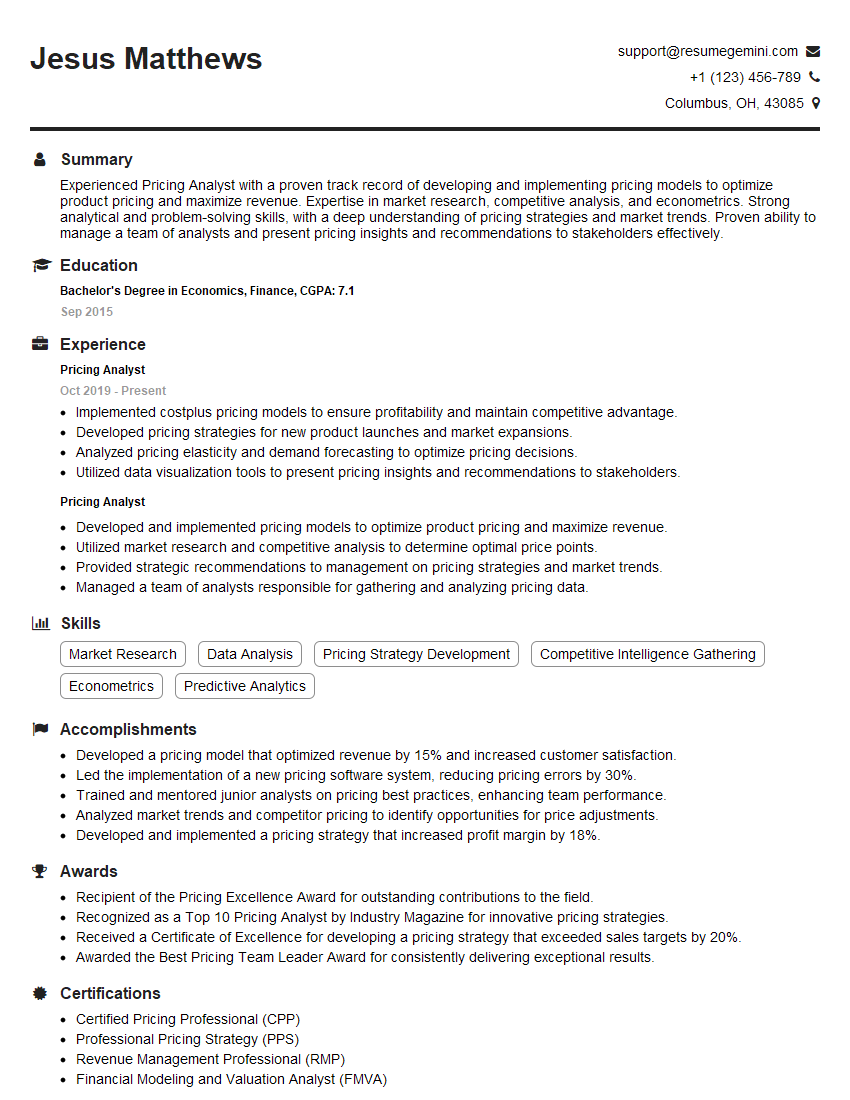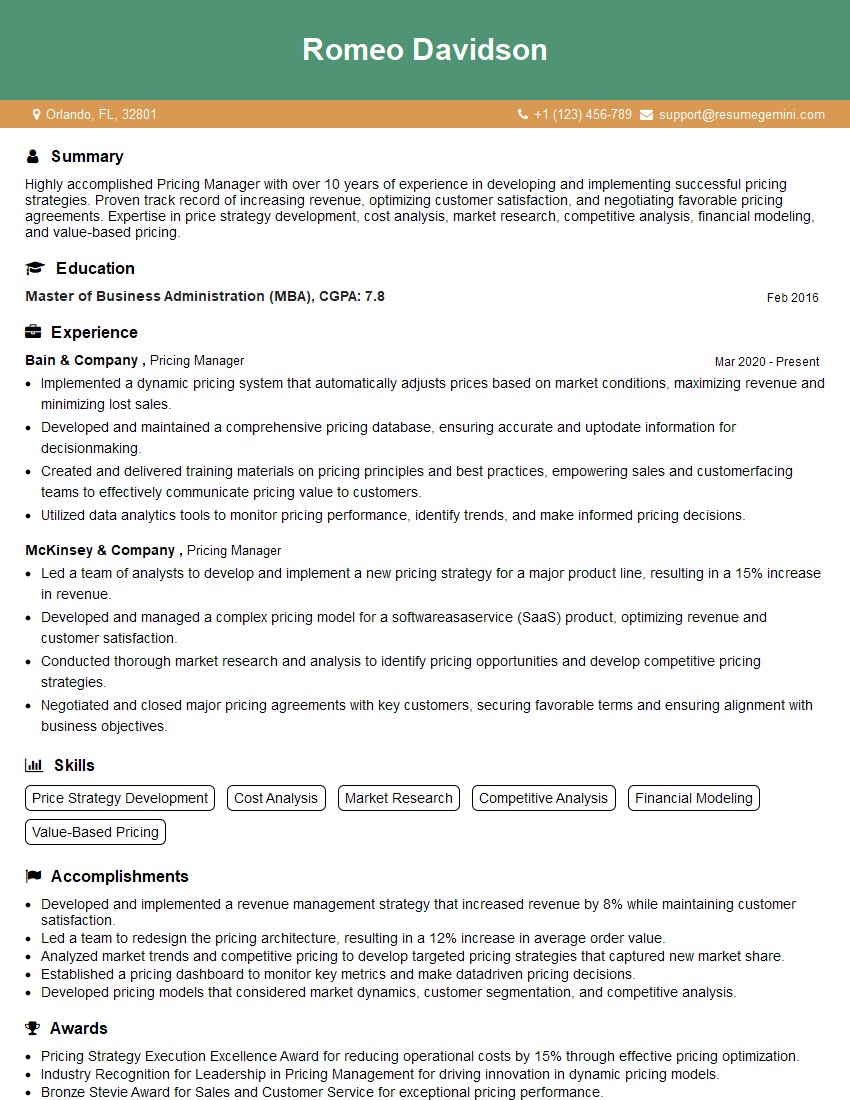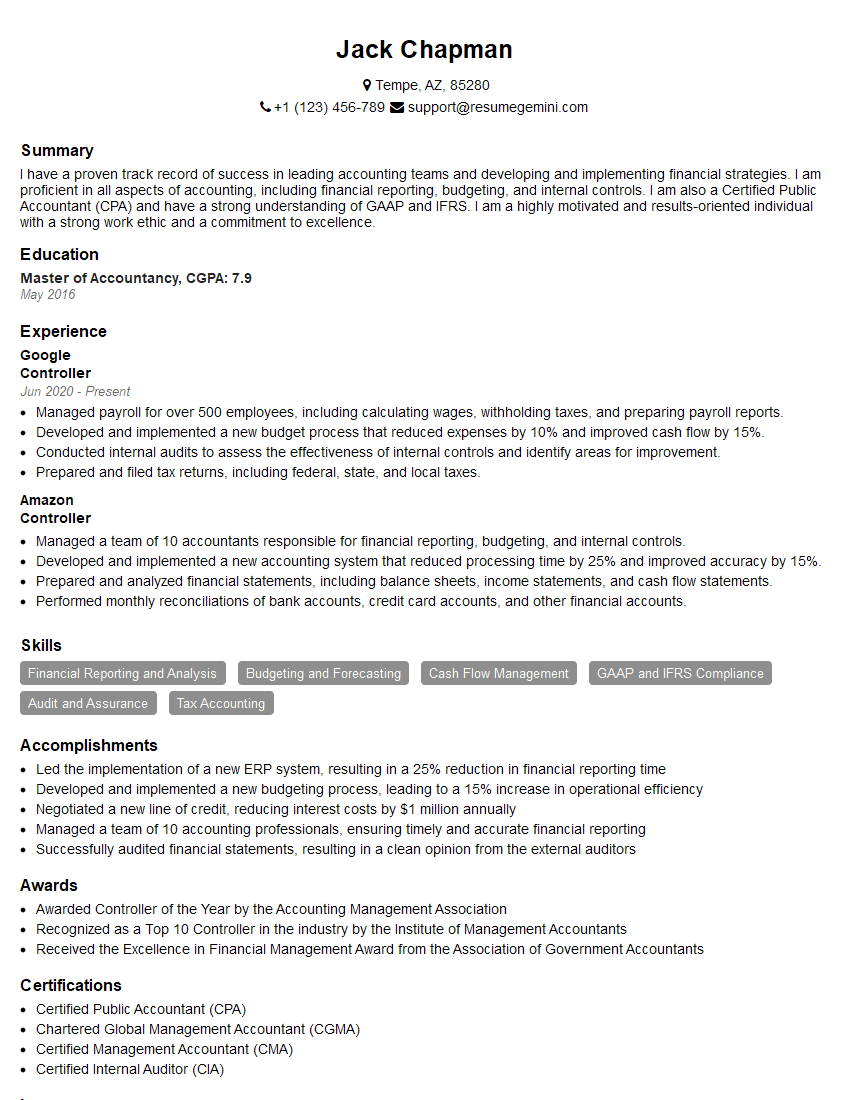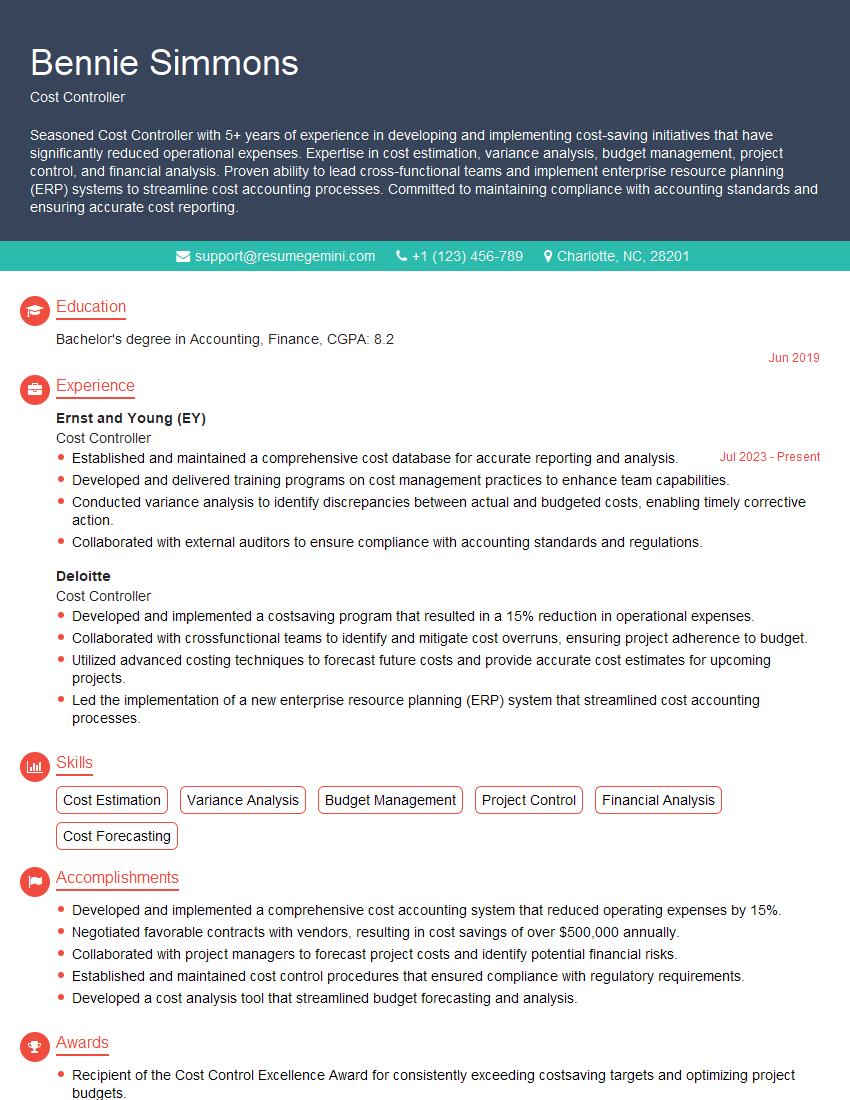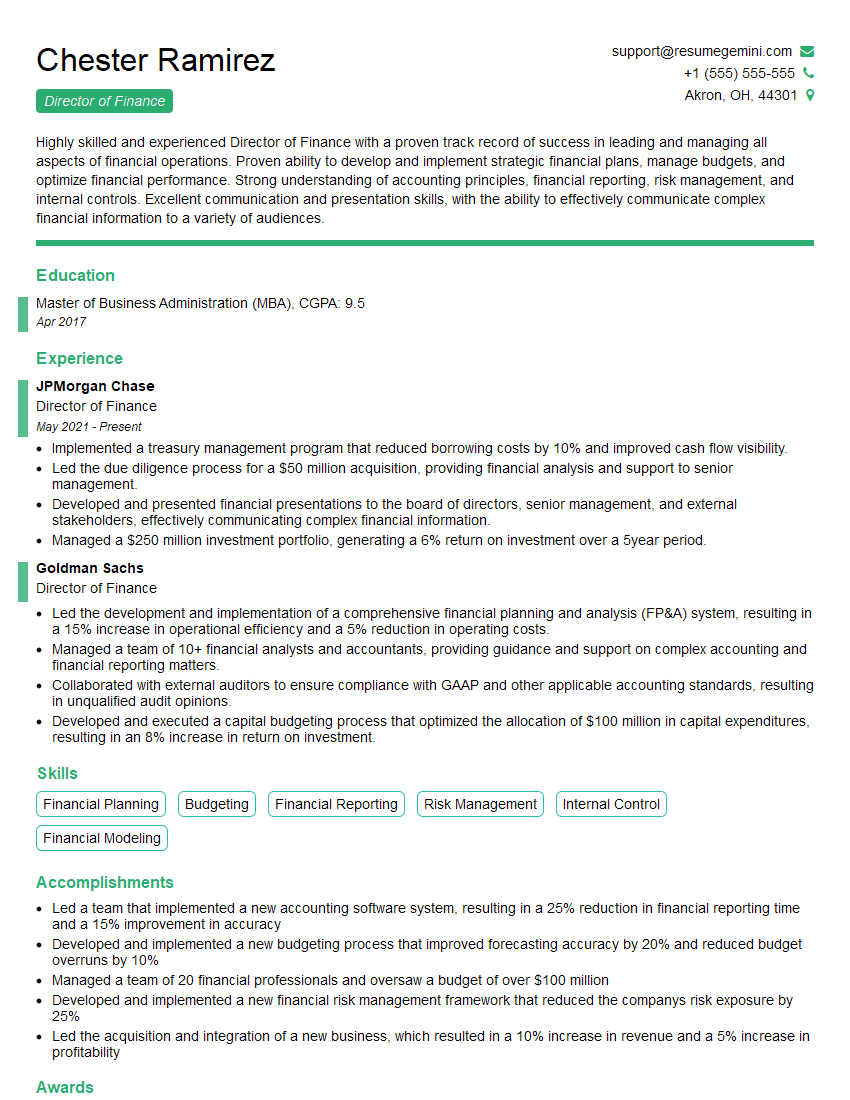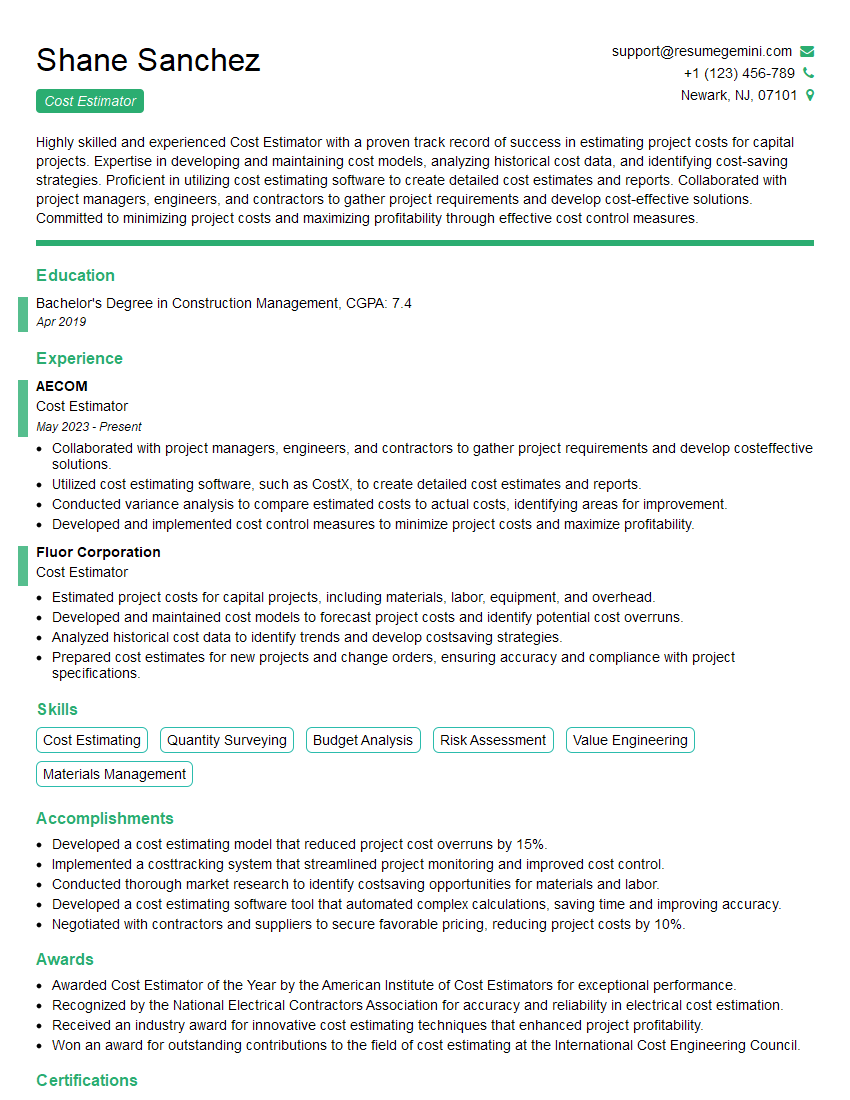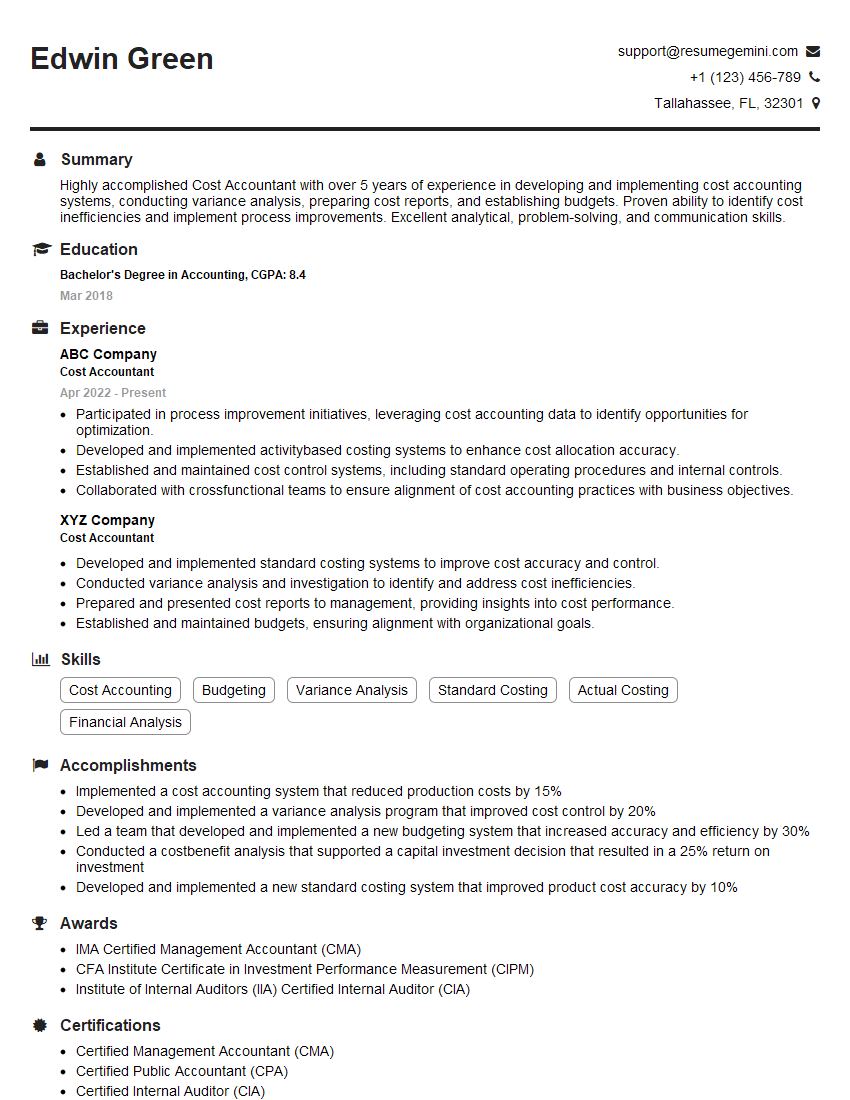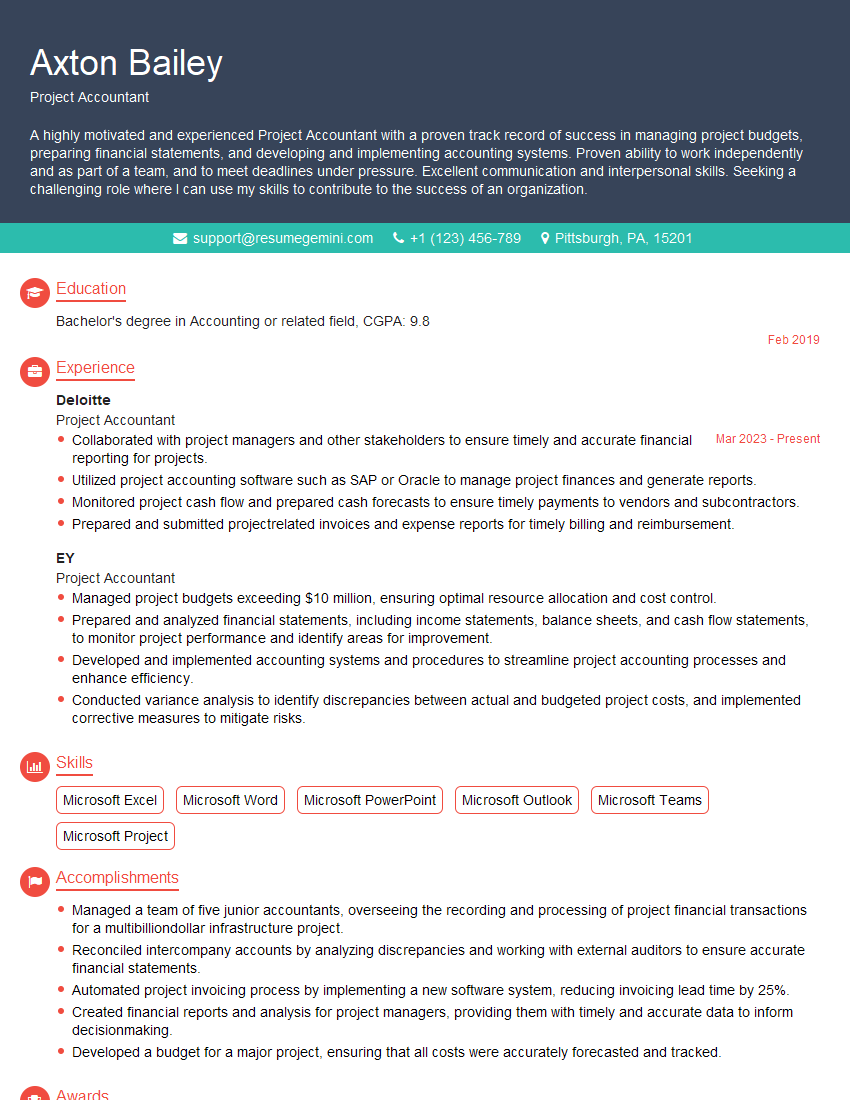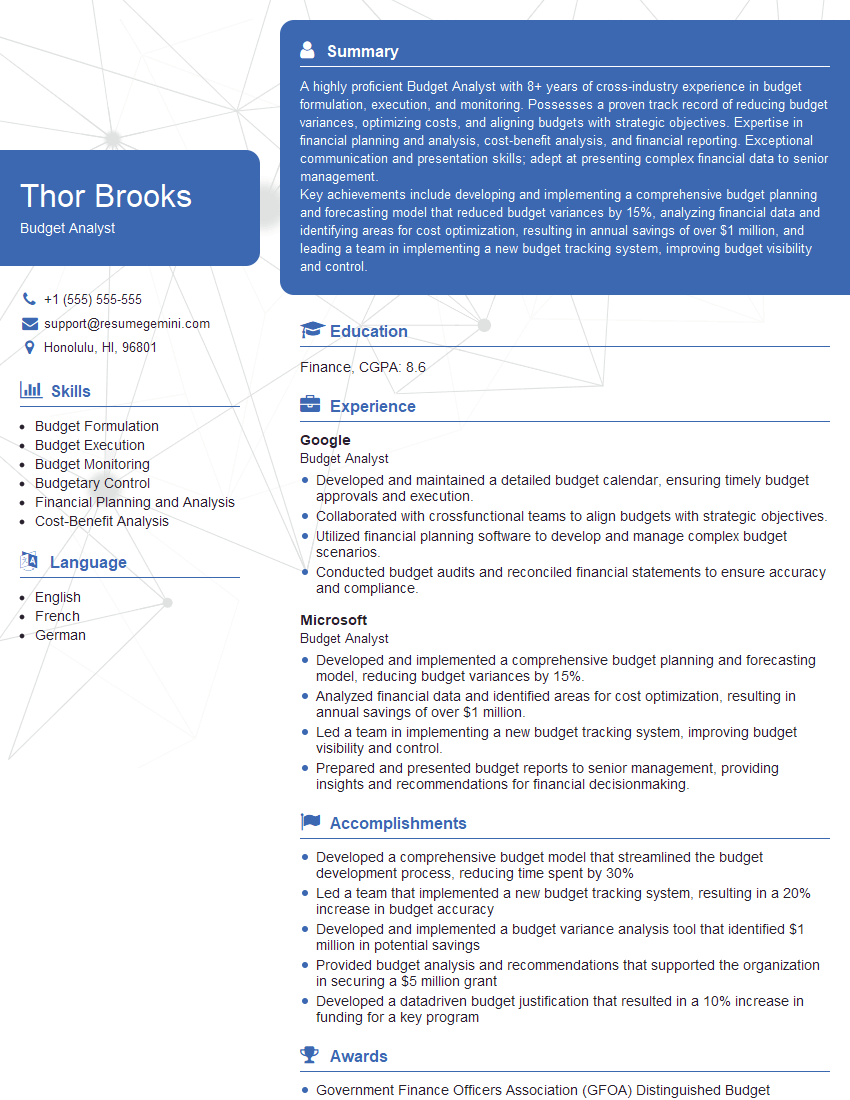The thought of an interview can be nerve-wracking, but the right preparation can make all the difference. Explore this comprehensive guide to Job Costing and Pricing interview questions and gain the confidence you need to showcase your abilities and secure the role.
Questions Asked in Job Costing and Pricing Interview
Q 1. Explain the difference between job costing and process costing.
Job costing and process costing are two distinct methods for assigning costs to products or services. The core difference lies in the nature of the product or service being produced.
Job costing is used when producing unique, customized products or services, where each job or project has its own distinct cost. Think of a construction company building a house, a custom cake bakery creating a wedding cake, or a software development firm building a bespoke application. Each job is different, and materials, labor, and overhead are tracked separately for each.
Process costing, on the other hand, is applied when producing homogeneous products in mass quantities, where individual units are indistinguishable. Examples include a bottling plant producing soda, a cement factory making cement, or a bakery producing thousands of identical cookies. Costs are tracked and averaged across the entire production process, rather than for each individual unit.
In essence, job costing focuses on individual jobs, while process costing focuses on the entire production process.
Q 2. What are the key elements of a job cost sheet?
A job cost sheet is a document that summarizes all the costs associated with a specific job. It’s crucial for tracking costs and determining profitability. Key elements include:
- Job Number: A unique identifier for each job.
- Customer Name: Identifies the client for whom the job was performed.
- Description of Work: Details the work performed for the job.
- Direct Materials: A listing of all raw materials used, including quantities and costs. For example, lumber, concrete, or software licenses.
- Direct Labor: Costs of labor directly involved in the job, including employee wages and benefits. This could be carpenters’ wages for a construction job or programmers’ salaries for a software project.
- Overhead Costs: Indirect costs allocated to the job, such as factory rent, utilities, or administrative salaries. The method of allocation varies (discussed in a later question).
- Total Cost: The sum of direct materials, direct labor, and overhead costs.
- Selling Price: The price at which the job was sold to the customer.
- Profit/Loss: The difference between the selling price and the total cost.
Q 3. How do you calculate the cost of goods sold (COGS) using job costing?
Calculating Cost of Goods Sold (COGS) under job costing is straightforward. It involves summing the costs of all completed jobs sold during a period.
For example: Let’s say a construction company completed and sold three houses during the year. The individual job cost sheets show the following total costs:
- House 1: $200,000
- House 2: $250,000
- House 3: $220,000
The COGS for the year would be $200,000 + $250,000 + $220,000 = $670,000. This figure is then used in the company’s income statement.
Q 4. Describe the different methods for allocating overhead costs in job costing.
Several methods exist for allocating overhead costs in job costing. The choice depends on the nature of the business and the level of accuracy desired.
- Predetermined Overhead Rate Method: This is the most common method. A predetermined overhead rate is calculated at the beginning of the accounting period by dividing the estimated overhead costs by the estimated activity base (e.g., direct labor hours, machine hours, or direct labor costs). This rate is then applied to each job based on the actual activity consumed by that job.
Predetermined Overhead Rate = Estimated Overhead Costs / Estimated Activity Base - Actual Overhead Rate Method: In this method, the actual overhead costs are divided by the actual activity base at the end of the period to determine the overhead rate. This method is less common because it requires waiting until the end of the period to know the final costs, making timely cost determination difficult.
- Multiple Overhead Rate Method: When overhead costs are driven by different activities, using a single overhead rate can be inaccurate. The multiple overhead rate method uses separate rates for different cost pools (e.g., machine setup costs, materials handling costs). Each cost pool has its own activity base and predetermined rate.
For instance, a manufacturing company might use machine hours as the activity base for machinery-related overhead and direct labor hours for labor-related overhead, leading to two distinct overhead rates.
Q 5. What are some common challenges in accurately assigning overhead costs?
Accurately assigning overhead costs presents several challenges:
- Identifying appropriate cost drivers: Determining the most accurate activity base to allocate overhead can be subjective. Some overhead costs may be driven by multiple factors, making it difficult to find a single appropriate driver.
- Estimating overhead costs: Predicting future overhead costs is inherently uncertain. Inaccurate estimations lead to misallocation of overhead costs.
- Fluctuations in activity levels: Significant variations in actual activity levels compared to the budgeted activity level can distort the accuracy of the predetermined overhead rate.
- Complexity of allocation: In larger organizations with complex production processes, tracing overhead costs to individual jobs accurately can be incredibly complex.
For example, it’s difficult to accurately allocate the cost of a building’s electricity entirely to one specific job when several jobs use that building.
Q 6. How do you handle variances between actual and budgeted costs in a job costing system?
Variances between actual and budgeted costs in a job costing system are analyzed to understand the reasons for deviations and improve future cost estimations. The process usually involves:
- Calculating variances: Determine the difference between actual and budgeted costs for each cost element (direct materials, direct labor, overhead).
- Investigating causes: Analyze the reasons behind the variances. For instance, a materials price variance might be due to changes in raw material prices, while a labor rate variance could stem from wage increases or employee inefficiencies.
- Taking corrective actions: Based on the analysis, implement corrective measures to address the identified issues. This could involve renegotiating supplier contracts, improving production processes, or adjusting employee training.
- Using variances for future planning: In future budgeting, incorporate lessons learned from the variances to improve the accuracy of cost estimations.
For example, if the actual direct labor costs exceeded the budget, the company might investigate whether this is due to inefficient processes, requiring process improvements, or whether it reflects a justifiable increase in employee wages.
Q 7. Explain the concept of a cost driver and provide examples.
A cost driver is an activity or factor that causes a change in the cost of a product or service. It’s used to allocate overhead costs accurately to jobs. The stronger the relationship between the cost driver and the overhead cost, the more accurate the allocation.
Examples of cost drivers include:
- Direct labor hours: Used when overhead costs are primarily driven by the amount of labor used.
- Machine hours: Appropriate when overhead costs relate to the usage of machinery.
- Number of setups: Suitable when costs are associated with setting up machines for production runs.
- Number of inspections: Relevant when quality control inspection costs are significant.
- Number of purchase orders: A useful driver if purchasing costs represent a substantial part of overhead.
Consider a printing company. The number of printing jobs (or the number of machine hours used) could be a cost driver for electricity and machine maintenance costs. If the company does a lot of small print jobs, these costs will be spread over more jobs than if they do fewer, larger jobs.
Q 8. How do you determine the profitability of a specific job or project?
Determining the profitability of a specific job or project involves comparing the total revenue generated against the total costs incurred. It’s essentially a simple formula: Profit = Revenue – Costs. However, accurately calculating both revenue and costs is crucial. Revenue is straightforward – the amount you charged the client. Costs, however, need a more nuanced approach.
Job costing is vital here. It involves tracking all direct and indirect costs associated with that particular project. Direct costs are easily attributable to the job (e.g., materials used, labor hours directly spent on the project). Indirect costs are those shared across multiple jobs (e.g., rent, utilities, administrative salaries). These indirect costs need to be allocated appropriately using a suitable overhead allocation method, such as machine hours or direct labor costs.
Example: Let’s say a construction project generated $100,000 in revenue. Direct costs (materials, labor specifically for that project) totaled $60,000, and allocated indirect costs (portion of overhead) were $15,000. The profit would be $100,000 – $60,000 – $15,000 = $25,000. A negative result indicates a loss. Regularly analyzing job profitability helps identify areas for improvement in efficiency and pricing.
Q 9. What are the key factors to consider when setting prices for a product or service?
Setting prices requires a careful balancing act between various factors. The goal is to find a price point that maximizes profitability while remaining competitive and attractive to customers. Key factors include:
- Cost of Goods Sold (COGS): This encompasses all direct costs involved in producing your product or service. You cannot price below this unless you plan to operate at a loss.
- Operating Expenses: These include indirect costs such as rent, salaries, marketing, and administrative expenses. These need to be factored into your pricing to cover your overhead.
- Desired Profit Margin: This represents the percentage of profit you aim to achieve on each sale. It should reflect your business goals and risk tolerance.
- Market Conditions: Understanding your competitors’ pricing, market demand, and customer willingness to pay are crucial. A high-demand product or service allows for higher pricing.
- Value Proposition: Your price should reflect the perceived value your product or service offers to customers. A premium product with unique features or benefits commands a higher price.
Ignoring any of these factors can lead to underpricing (loss of profits) or overpricing (loss of sales).
Q 10. Explain different pricing strategies (e.g., cost-plus, value-based, competitive).
Different pricing strategies cater to different business models and market conditions:
- Cost-Plus Pricing: This involves calculating the total cost of production and adding a fixed markup percentage to determine the selling price. It’s simple but doesn’t consider market demand or competition.
Selling Price = Cost + (Cost * Markup Percentage) - Value-Based Pricing: This focuses on the perceived value to the customer. It’s less about the cost of production and more about the benefits the customer receives. Luxury goods often use this strategy.
- Competitive Pricing: This involves setting prices based on what competitors are charging. It’s suitable for highly competitive markets but risks a price war if not managed carefully.
- Premium Pricing: This strategy involves setting a high price to signal high quality and exclusivity. It works well for luxury or specialized products.
- Penetration Pricing: A low price initially used to quickly gain market share, often followed by price increases as market dominance grows.
The choice of strategy depends on the industry, competitive landscape, and the nature of the product or service.
Q 11. How do you analyze the profitability of different pricing strategies?
Analyzing the profitability of different pricing strategies requires a detailed understanding of cost structures and revenue generation at each price point. This often involves:
- Break-Even Analysis: Determining the sales volume required to cover all costs at different prices.
- Sensitivity Analysis: Assessing the impact of changes in various factors (e.g., material costs, sales volume) on profitability under different pricing models.
- Market Research and Sales Data: Tracking sales volume and revenue at different price points to assess customer response and profitability.
- Margin Analysis: Calculating the gross profit margin (gross profit/revenue) and net profit margin (net profit/revenue) for each strategy to determine its overall profitability.
Example: You could compare the profit generated at different price points under cost-plus, value-based, and competitive pricing strategies using historical sales data and projected sales volumes at different prices. This allows you to choose the strategy that maximizes profitability while considering the market’s response.
Q 12. How do you incorporate market research into your pricing decisions?
Market research plays a vital role in informed pricing decisions. It helps in understanding customer needs, preferences, and willingness to pay. Methods include:
- Surveys and Focus Groups: Gathering direct feedback from potential customers on price sensitivity and product value.
- Competitive Analysis: Studying competitors’ pricing strategies, product offerings, and market positioning.
- Market Segmentation: Identifying distinct customer groups with different price sensitivities and tailoring pricing strategies accordingly.
- Price Elasticity of Demand Studies: Assessing how changes in price affect demand. This helps determine the optimal price point to maximize revenue.
Example: Before launching a new software product, conducting surveys to understand the perceived value and price tolerance among different customer segments (e.g., small businesses, enterprises) would provide valuable data for setting the optimal pricing strategy.
Q 13. What is the impact of changes in raw material costs on pricing?
Changes in raw material costs directly impact pricing decisions, especially in industries with fluctuating commodity prices. Rising raw material costs increase the cost of production, potentially squeezing profit margins. Several approaches can be taken:
- Pass-Through Pricing: Increasing prices to offset the rise in raw material costs. This is common but could alienate price-sensitive customers.
- Cost Reduction Strategies: Exploring ways to reduce other costs (e.g., streamlining production, negotiating better deals with suppliers) to mitigate the impact of rising material costs.
- Value Engineering: Finding alternative materials or production methods to reduce overall costs without significantly impacting product quality.
- Absorbing Costs: Accepting reduced profit margins in the short term to maintain competitiveness; however, this is not sustainable in the long run.
Regularly monitoring raw material prices and incorporating cost projections into pricing models is crucial for managing price volatility and maintaining profitability.
Q 14. How do you handle price negotiations with customers?
Price negotiations require a strategic approach that balances customer satisfaction with business profitability. Key aspects include:
- Preparation: Thoroughly understand your cost structure, pricing strategy, and the customer’s needs and budget.
- Value Articulation: Clearly communicate the value proposition of your product or service and how it justifies the price.
- Flexibility: Be prepared to offer different pricing packages or options to cater to the customer’s specific requirements. This could involve adjusting quantities, features, or payment terms.
- Win-Win Approach: Aim for a solution that satisfies both parties. This could involve compromising on certain aspects to secure the deal.
- Documentation: Clearly document all agreed-upon terms and conditions to avoid future disputes.
Example: During negotiations, you might offer a discount in exchange for an earlier payment or a larger order volume. This demonstrates flexibility and a willingness to work together towards a mutually beneficial agreement.
Q 15. What are the ethical considerations in pricing?
Ethical pricing ensures fairness and transparency in setting prices. It involves avoiding deceptive practices, respecting competition, and considering the needs of all stakeholders. This means not exploiting customers by charging exorbitant prices, especially during times of crisis or when dealing with vulnerable populations. It also means not engaging in predatory pricing, where prices are artificially lowered to drive out competitors and then raised later. A key ethical consideration is cost transparency – customers should have a reasonable understanding of how the price is derived.
For example, imagine a construction company bidding on a project for a low-income housing development. Ethical pricing would involve setting a price that covers all costs, ensures a fair profit margin, but also reflects the social responsibility of providing affordable housing. This might mean accepting a lower profit margin than on a luxury project, demonstrating commitment to the project’s social value.
Another example: a pharmaceutical company setting prices for a life-saving medication. They need to balance the cost of research and development with the affordability for patients. Exorbitant pricing in such cases raises serious ethical concerns.
Career Expert Tips:
- Ace those interviews! Prepare effectively by reviewing the Top 50 Most Common Interview Questions on ResumeGemini.
- Navigate your job search with confidence! Explore a wide range of Career Tips on ResumeGemini. Learn about common challenges and recommendations to overcome them.
- Craft the perfect resume! Master the Art of Resume Writing with ResumeGemini’s guide. Showcase your unique qualifications and achievements effectively.
- Don’t miss out on holiday savings! Build your dream resume with ResumeGemini’s ATS optimized templates.
Q 16. What software or tools do you use for job costing and pricing?
My experience encompasses several software tools for job costing and pricing. I’ve extensively used enterprise resource planning (ERP) systems like SAP and Oracle, which provide comprehensive modules for tracking costs, managing projects, and generating pricing reports. These systems offer features for detailed cost allocation, real-time tracking of labor and materials, and integration with accounting functions for seamless financial management. For smaller projects or where integration with existing systems is limited, I’ve also used specialized job costing software, such as QuickBooks Contractor and JobBOSS, which are easier to implement and more affordable.
In addition to software, I’m proficient in using spreadsheet software like Microsoft Excel and Google Sheets for creating detailed cost breakdowns, performing what-if analyses, and developing pricing models. Spreadsheets are incredibly versatile and can adapt to various costing methodologies.
Q 17. Describe your experience with cost-volume-profit (CVP) analysis.
Cost-Volume-Profit (CVP) analysis is a crucial management accounting tool that examines the relationship between the volume of goods or services sold, the costs incurred, and the resulting profit. It helps businesses understand how changes in sales volume, costs, and prices affect their profitability. I’ve used CVP extensively to predict profitability under different scenarios, such as changes in sales volume, pricing strategies, and cost structures.
A common application involves break-even analysis, determining the sales volume needed to cover all costs. I frequently use CVP in preparing budgets and forecasts, identifying the optimal sales mix, and making pricing decisions. For example, if we anticipate a decrease in sales volume, CVP analysis helps us determine what adjustments to costs or prices we need to maintain profitability. It allows for ‘what-if’ scenario planning to mitigate risks and capitalize on opportunities.
For example, I once used CVP analysis to determine the optimal pricing strategy for a new product launch. By considering variable costs, fixed costs, and anticipated sales volume, I could assess the profit potential across various price points and recommend a price that maximized profitability while remaining competitive in the market.
Q 18. How do you use break-even analysis in your decision-making?
Break-even analysis, a core component of CVP analysis, is instrumental in my decision-making process. It helps determine the point where total revenue equals total costs, resulting in neither profit nor loss. This critical benchmark informs several decisions:
- Pricing Strategies: Break-even analysis guides pricing decisions by showing how changes in price impact the required sales volume to break even. If a price increase is considered, the analysis reveals how much the sales volume can drop before becoming unprofitable.
- Capacity Planning: It informs capacity planning decisions by assessing the necessary sales volume to utilize production capacity effectively and efficiently. Investing in additional capacity becomes justified when the expected sales volume surpasses the break-even point for the expanded capacity.
- Product Mix Decisions: When dealing with multiple products, break-even analysis for each product, and their combined effect, helps in deciding which product lines to prioritize based on their relative profitability and contribution to covering fixed costs.
- Cost Reduction Strategies: It highlights areas where cost reduction efforts can be most effective by demonstrating how reducing fixed or variable costs lowers the break-even point, enhancing profitability at lower sales volumes.
Essentially, break-even analysis provides a quantifiable benchmark for assessing the financial viability of various strategies and helps avoid decisions that might lead to losses.
Q 19. Explain the concept of target costing.
Target costing is a management approach where the desired selling price of a product is determined first, and then costs are engineered to meet that target. This contrasts with traditional cost-plus pricing, where costs are calculated, and a markup is added to determine the selling price. Target costing is particularly effective in highly competitive markets where prices are relatively fixed.
The process typically involves:
- Market Research: Determining the target selling price based on market conditions, competitor pricing, and customer demand.
- Target Costing: Subtracting desired profit margin from the target selling price to determine the maximum allowable cost.
- Cost Engineering: Identifying ways to reduce costs through design changes, process improvements, material substitutions, or alternative manufacturing techniques to meet the target cost.
For example, consider a car manufacturer aiming to launch a new model at a specific price point. They’ll first research competitor pricing and customer willingness to pay. Once the target price is set, the engineering team works to design and manufacture the car at or below the target cost without compromising key features.
Q 20. How do you deal with incomplete or inaccurate cost data?
Incomplete or inaccurate cost data poses significant challenges in job costing and pricing. My approach involves a multi-step process:
- Identify Gaps: The first step is to systematically identify where data is missing or suspect. This often requires reviewing existing data collection processes and identifying bottlenecks or areas needing improvement.
- Data Collection & Validation: Where possible, I’ll collect missing data. This might involve reviewing invoices, timesheets, and other documentation. If data is inaccurate, I’ll try to validate it using different sources or accounting techniques.
- Estimation Techniques: When data is completely unavailable, I’ll use estimation techniques, ensuring transparency about the assumptions made. Techniques include activity-based costing (ABC) and similar approaches to allocate costs more accurately.
- Sensitivity Analysis: Once cost estimates are established, I’ll conduct sensitivity analysis to determine how changes in these estimates affect the final price. This highlights the impact of uncertainty and helps manage risk.
- Continuous Improvement: Addressing the root causes of incomplete or inaccurate data is essential. This may involve implementing better data collection procedures, improving employee training, or investing in better software.
Transparency is key. Any estimations or assumptions used must be clearly documented and communicated to stakeholders.
Q 21. How do you manage the complexities of multi-product costing?
Multi-product costing introduces complexities in allocating overhead and indirect costs among various products. Accurate cost allocation is crucial for effective pricing and profitability analysis. I employ several techniques to manage these complexities:
- Activity-Based Costing (ABC): ABC is a powerful tool for assigning overhead costs based on activities that drive those costs. Instead of using a single overhead rate, ABC assigns costs to products based on their consumption of specific activities. This leads to more accurate product costing, especially in companies with diverse products and complex manufacturing processes.
- Multiple Cost Pools: Utilizing multiple cost pools for overhead allocation provides a more refined approach compared to using a single, plant-wide overhead rate. This is essential when diverse products consume overhead resources in different proportions.
- Cost Drivers: Identifying accurate cost drivers is critical for effective cost allocation. Cost drivers are factors that influence the level of overhead costs, such as machine hours, direct labor hours, or number of setups. A careful analysis of the production process is essential to select appropriate cost drivers.
- Software and Technology: Leveraging sophisticated accounting software and ERP systems helps manage and track costs effectively, simplifying cost allocation across different product lines. These systems provide capabilities for automating cost calculations and generating detailed reports.
By employing these techniques, I can accurately allocate costs, provide insightful pricing information, and contribute to better decision-making in a multi-product environment.
Q 22. What are some key performance indicators (KPIs) used in job costing and pricing?
Key Performance Indicators (KPIs) in job costing and pricing are crucial for monitoring efficiency, profitability, and overall project health. They provide insights into whether projects are on track and help identify areas for improvement. Common KPIs include:
- Gross Profit Margin: (Revenue – Direct Costs) / Revenue. This shows the profitability of each job after deducting direct costs (materials, labor). A low margin might indicate pricing issues or cost overruns.
- Project Cost Variance: Actual Cost – Budgeted Cost. This highlights the difference between planned and actual expenses. A positive variance indicates cost overruns, while a negative variance represents cost underruns.
- Schedule Variance: Actual Completion Time – Planned Completion Time. This KPI measures the project’s adherence to the schedule. Significant delays could impact profitability and client satisfaction.
- Labor Efficiency: Actual Labor Hours / Budgeted Labor Hours. This shows how efficiently labor resources are utilized. High efficiency suggests effective planning and execution, while low efficiency may point to skill gaps or process inefficiencies.
- Material Usage Variance: Actual Material Cost – Budgeted Material Cost. This helps identify discrepancies between the planned and actual material consumption. Significant deviations could result from waste, theft, or inaccurate estimations.
- Return on Investment (ROI): Net Profit / Total Investment. This measures the overall profitability of a project relative to the investment made. It provides a holistic view of project success.
By regularly monitoring these KPIs, businesses can make data-driven decisions to optimize their job costing and pricing strategies, leading to improved profitability and project success.
Q 23. How do you communicate cost and pricing information to non-financial stakeholders?
Communicating cost and pricing information to non-financial stakeholders requires clear, concise, and visually appealing presentations. Avoid technical jargon and focus on the big picture. I typically use the following strategies:
- Visualizations: Charts and graphs (bar charts for comparing project costs, pie charts for cost breakdowns) make complex data easily digestible.
- Storytelling: Framing the data within a narrative helps stakeholders understand the context and impact of cost and pricing decisions. For example, “This project is slightly over budget due to unexpected material costs, but we’ve implemented measures to mitigate future overruns.”
- Key Metrics Only: Present only the most relevant KPIs, avoiding information overload. Focus on the information that directly affects their area of responsibility.
- Analogies and Real-World Examples: Relate cost and pricing information to scenarios that are familiar to the audience. For instance, “The additional $5,000 is equivalent to the cost of one extra employee for a month.”
- Interactive Dashboards: If possible, provide interactive dashboards that allow stakeholders to explore the data independently and at their own pace.
The goal is to empower stakeholders with the information they need to understand and participate in informed decision-making, without overwhelming them with technical detail.
Q 24. Describe your experience with variance analysis and corrective actions.
Variance analysis is a critical part of my job costing process. It involves comparing actual results to planned or budgeted figures and identifying the reasons for any discrepancies. I’ve used a systematic approach involving these steps:
- Identify Variances: Calculate the difference between actual and budgeted costs for each cost element (labor, materials, overhead).
- Analyze Variances: Investigate the reasons for the variances. For example, material cost variances could be due to price increases, waste, or theft; labor variances could be due to inefficiencies, overtime, or skill gaps.
- Categorize Variances: Classify variances as either favorable (cost underruns) or unfavorable (cost overruns).
- Investigate Root Causes: Conduct thorough investigations to understand the root causes of significant variances. This may involve interviewing project managers, reviewing timesheets, and examining purchase orders.
- Develop Corrective Actions: Based on the root cause analysis, implement corrective actions to prevent similar variances from occurring in the future. This might include process improvements, better material management, improved labor scheduling, or revised project planning.
- Monitor and Evaluate: Track the effectiveness of corrective actions and make further adjustments as needed.
For example, I once identified a significant unfavorable labor variance on a project. Through investigation, I found that the initial project estimates had underestimated the complexity of certain tasks, leading to increased labor hours. We revised our estimation process and incorporated lessons learned into future projects.
Q 25. How do you identify and manage risks associated with cost overruns?
Managing the risk of cost overruns requires a proactive and multi-faceted approach. My strategy involves:
- Accurate Cost Estimation: Develop detailed and realistic cost estimates at the beginning of each project. This involves meticulous planning, thorough research, and considering potential risks and uncertainties. Utilizing historical data and benchmarking against similar projects is vital.
- Regular Monitoring and Reporting: Track project costs closely throughout the project lifecycle. Regular progress reports and variance analyses help identify potential problems early on.
- Contingency Planning: Include a contingency buffer in the budget to account for unforeseen events or changes in scope. This buffer serves as a safety net for unexpected costs.
- Risk Assessment and Mitigation: Identify potential risks (e.g., material price fluctuations, labor shortages, changes in regulations) and develop mitigation strategies. This may involve negotiating fixed-price contracts with suppliers, securing skilled labor in advance, or implementing robust project management processes.
- Change Management Procedures: Establish clear procedures for managing changes to the project scope. All change requests should be thoroughly evaluated, with associated costs and timelines documented before approval.
- Value Engineering: Regularly review the project design and specifications to identify opportunities to reduce costs without sacrificing quality or functionality.
By implementing these measures, businesses can significantly reduce the likelihood of cost overruns and enhance the overall success of their projects.
Q 26. How do you ensure accuracy and integrity in your job costing and pricing data?
Ensuring accuracy and integrity in job costing and pricing data is paramount. My approach combines robust processes and technology:
- Data Validation and Verification: Implement checks and balances to ensure data accuracy at every stage of the process. This includes validating data entered into the system, reconciling purchase orders with invoices, and verifying timesheets against project records.
- Automated Data Entry: Use technology to automate data entry whenever possible. This reduces manual errors and increases efficiency. Integrating accounting and project management software improves data flow and consistency.
- Regular Audits: Conduct regular audits of job costing and pricing data to identify and correct any inconsistencies or errors. This could include internal audits or external reviews by independent professionals.
- Access Control and Security: Restrict access to sensitive data to authorized personnel only. Implement security measures to prevent unauthorized access, modification, or deletion of data.
- Clear Documentation: Maintain clear and comprehensive documentation of all job costing and pricing processes and procedures. This facilitates auditing, training, and ongoing improvements.
- Training and Competency: Provide thorough training to personnel involved in data collection, entry, and analysis. Ensure they understand the importance of data accuracy and the procedures for handling any discrepancies.
By adopting these measures, organizations can enhance the reliability and trustworthiness of their job costing and pricing data, enabling accurate reporting and informed decision-making.
Q 27. Explain your approach to continuous improvement in cost management.
Continuous improvement in cost management is an ongoing process. My approach involves a combination of proactive measures and reactive adjustments:
- Benchmarking: Regularly compare our cost structures and performance against industry best practices and competitors. This helps identify areas where we can improve efficiency and reduce costs.
- Process Optimization: Continuously evaluate existing processes to identify bottlenecks and inefficiencies. Implementing lean principles (reducing waste, improving workflow) can significantly improve cost effectiveness.
- Technology Adoption: Explore and adopt new technologies to automate processes, improve data accuracy, and enhance decision-making. This could include adopting advanced project management software, robotic process automation, or data analytics tools.
- Employee Empowerment: Encourage employees to identify cost-saving opportunities and reward them for their contributions. Empowered employees are more likely to suggest innovative solutions to improve cost efficiency.
- Regular Reviews and Feedback: Conduct regular reviews of job costing data, seeking feedback from project managers and other stakeholders to identify areas needing improvement.
- Kaizen Events: Organize focused improvement events (Kaizen events) to address specific cost-related issues. These events bring together relevant stakeholders to brainstorm and implement solutions collaboratively.
This iterative approach ensures a culture of continuous improvement, where cost management practices are constantly being evaluated and refined.
Q 28. Describe a situation where you had to make a difficult decision related to pricing or costing.
In a previous role, we faced a difficult decision regarding pricing a new project. The initial cost estimates were significantly higher than anticipated due to unforeseen complexities. We had two options: significantly increase the price to ensure profitability or accept a lower profit margin to secure the contract, potentially impacting overall financial performance.
We addressed this by:
- Re-evaluating the Scope: We meticulously reviewed the project scope to identify areas where we could streamline processes or reduce costs without compromising quality. This involved collaboration with the client.
- Negotiating with Suppliers: We revisited our contracts with suppliers, exploring opportunities for better pricing or extended payment terms.
- Value Proposition: We carefully considered the value the project offered the client and presented a tiered pricing structure, offering varying levels of service at different price points.
- Risk Assessment: We analyzed the potential risks associated with both options (increased price leading to losing the contract versus reduced profitability). We weighed the long-term implications of each choice against the short-term gains or losses.
Ultimately, we chose a slightly increased price while presenting additional value to the client. This led to securing the contract with a reasonable profit margin. The experience highlighted the importance of thorough initial estimations, flexible pricing strategies, and open communication with clients.
Key Topics to Learn for Job Costing and Pricing Interview
- Direct Costs vs. Indirect Costs: Understanding the difference and how to accurately allocate each in job costing. Practical application: Analyzing a project’s cost breakdown to identify areas for potential savings.
- Overhead Allocation Methods: Mastering various methods like plantwide, departmental, and activity-based costing. Practical application: Choosing the most appropriate method for a given company and its projects, justifying your choice.
- Job Costing Systems: Familiarity with different job costing systems and their implementation. Practical application: Explaining the process of tracking costs from initiation to completion of a project.
- Cost Estimation Techniques: Exploring various techniques like top-down, bottom-up, and parametric estimating. Practical application: Developing accurate cost estimates for new projects, including considerations for potential risks and uncertainties.
- Pricing Strategies: Understanding cost-plus pricing, target pricing, and value-based pricing. Practical application: Determining the optimal pricing strategy for a specific project considering market conditions and competitor analysis.
- Variance Analysis: Analyzing cost variances (material, labor, overhead) to identify causes and corrective actions. Practical application: Presenting a variance analysis report and recommending actions to improve future cost management.
- Profitability Analysis: Assessing the profitability of individual jobs and projects. Practical application: Identifying profitable and unprofitable projects to make informed business decisions.
- Software Applications: Demonstrating familiarity with common job costing and project management software (mentioning specific software is optional, focusing on general knowledge is preferable).
Next Steps
Mastering Job Costing and Pricing is crucial for career advancement in accounting, finance, and project management. A strong understanding of these concepts demonstrates valuable analytical and problem-solving skills, opening doors to higher-paying roles and increased responsibilities. To enhance your job prospects, creating a compelling and ATS-friendly resume is paramount. ResumeGemini is a trusted resource that can help you craft a professional resume that highlights your skills and experience effectively. Examples of resumes tailored to Job Costing and Pricing are available to guide you. Take this opportunity to showcase your expertise and land your dream job!
Explore more articles
Users Rating of Our Blogs
Share Your Experience
We value your feedback! Please rate our content and share your thoughts (optional).
What Readers Say About Our Blog
Hi, I’m Jay, we have a few potential clients that are interested in your services, thought you might be a good fit. I’d love to talk about the details, when do you have time to talk?
Best,
Jay
Founder | CEO
